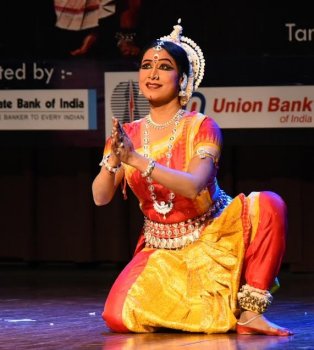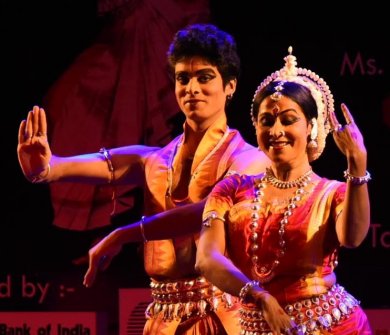
|   |

|   |
Fluidity and lyricism meet strict technique - Shveta Arora e-mail: shwetananoop@gmail.com Pics: Anoop Arora November 16, 2016 On the 23rd of October, Triveni Kala Sangam in Delhi was bedecked in beautiful flower rangolis all over the foyer, when Sujata Mohapatra and her disciple Soumya Das put up a performance under the Parampara series. On one hand, you saw the fluidity and lyricism in her dance, and on the other, her mastery over the technique of her guru Kelucharan Mohapatra to whose style she strictly adheres. After the mangalacharan, Sujata presented a pushpanjali to Lord Jagannath, “Jagannath swami nayan patha gami.” This was followed by a Ramastuti – the lord is neelam, or blue-coloured, like the peacock feathers, and has lotus feet. He wears the peeta vastram or the yellow dhoti, is sarasij nayan – lotus eyed – and holds the bow as a weapon. Lord Rama in the Sita swayamvara strung the Shiva dhanush and broke it. Rama was helped by Hanuman in his war on Lanka. Hanuman brought the Sanjeevani buti and the monkeys are his warriors. The abhinaya was perfect, with apt interpretations and depictions. The dance to depict the monkeys was especially well done and in the nritta part, each action was complete and consummate, with balancing stances and leaps. The choreography was by Guru Kelucharan Mohapatra and music by Pandit Raghunath Panigrahi.  Sujata Mohapatra The pallavi, a pure dance piece in raga Megha and taal ardhajhampa, culminated in fast-paced nritta. Sujata was technically flawless with chauka and slow lyrical movements. The choreography was by Ratikant Mohapatra and music by Pradeep K Das. The next piece was “Kedechhanda jaanila sahi” written by the Odiya bhakta poet Banamali. The composition depicts the leelas of the child Krishna. Mother Yashoda puts her child to sleep. The demoness Putana picks up the child and starts to suckle him. But Krishna bites her so hard that she cries in pain and dies. The depiction of the demoness by Sujata was very evocative. Krishna, while roaming the woods of Vrindavan, is attacked by Dhenukasura. Krishna holds him by his horns and after a battle, kills him. He also vanquishes Bakasura by holding his beak and tearing it apart. He is the one who drinks the agni in the woods and prevents it from spreading. When Indradeva is annoyed and there is incessant rain in Brajabhumi, Krishna lifts the mountain on his little finger and saves the cattle and people of Vrindavan from the wrath of Indra. When the waters of the Yamuna become poisonous due to the Kaliya naga, Krishna goes there to play with the ball, jumps into the water and vanquishes the serpent king. Finally, the last leela portrayed was that of little Krishna eating mud. Mother Yashoda chides him for doing so and insists that he open his mouth and she sees the entire universe inside it. The nritta part was again meticulously executed, and the abhinaya commendable. Special mention for the expressions of a mother who is annoyed and then shocked and then overawed, and lovingly hugs her child, kisses him and puts him to sleep. The choreography was by Guru Kelucharan Mohapatra and music by Pt Bhubaneswar Mishra.  Soumya Das and Sujata Mohapatra The final piece was Ardhanarishwara, which was presented by Sujata and her disciple Soumya Bose, who holds a Master’s degree in Odissi dance. The piece depicts the relationship of Lord Shiva and Parvati as two halves making a whole. Parvati is the left or the female energy, and Shiva is the right or the male energy. The dance presented both the lasya and tandava aspects. The two dancers compared the attributes of Shiva-Shakti. Parvati is gauri or fair, and Shiva is karpoor gaur, the whiteness of camphor. Parvati is adorned with ornaments, and Shiva has snakes entwined as ornaments. They bear the moon on their forehead. Parvati is the jagat janani, whereas Shiva is the god of destruction when he opens his third eye. Both have the trishul as their weapon. The freezes and stances were commendable, the footwork, hastas, abhinaya done with a lot of exactitude and great coordination and companionship. Sujata said that the choreography was initially a solo, “but when there is a male dancer available, we always bring in the male energy to the dance. It was Guruji’s favourite choreography, done for Sanjukta Panigrahi, and it was done for her tall frame and her energy. But for me, Guruji changed the choreography for my height and ability.” Shveta Arora is a blogger based in Delhi. She writes about cultural events in the capital. |